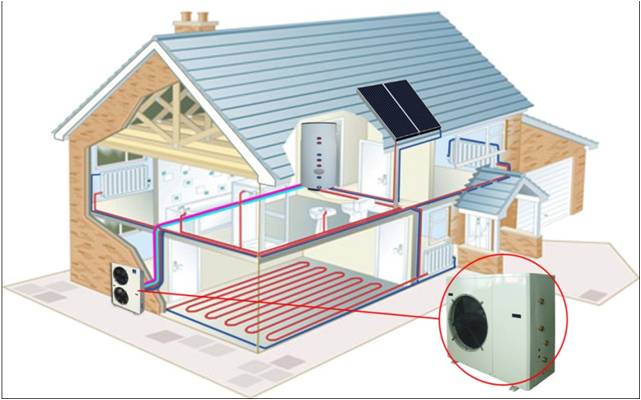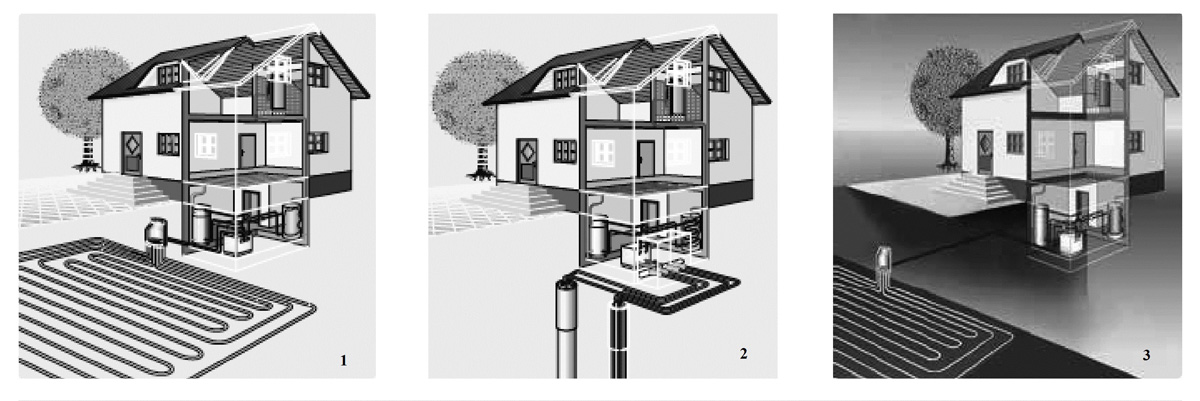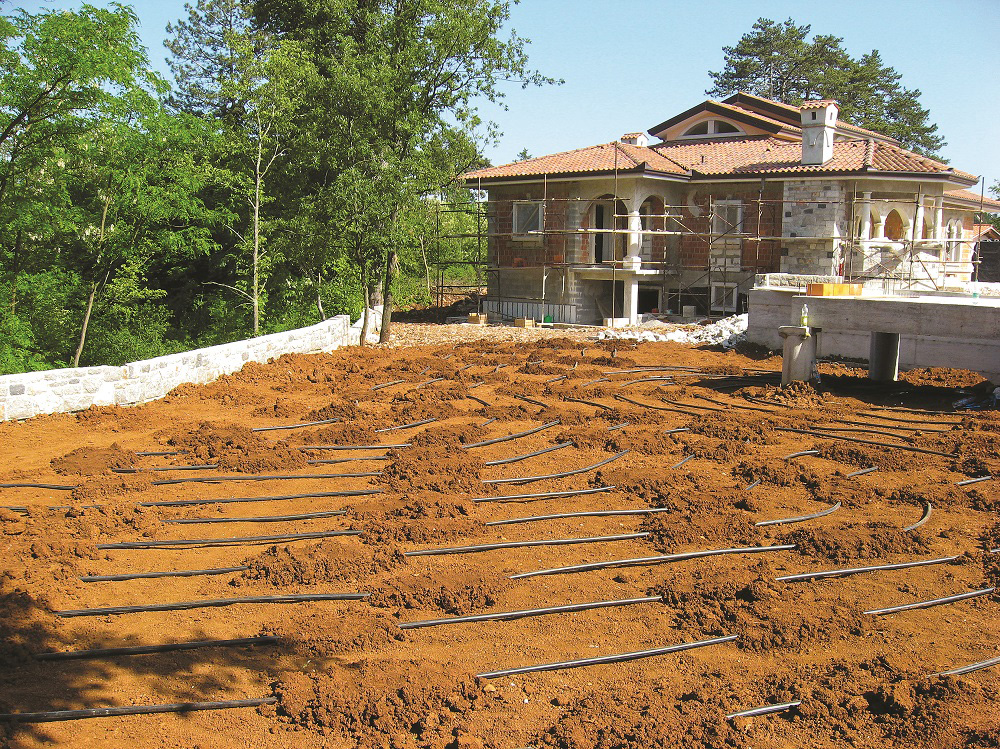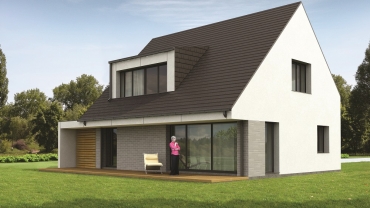
Aneta Vaitkienė
Heating by solid fuel – wood or coal is the cheapest. But the cheapies, as the saying goes, pay twice. In addition, twice a day you must climb down into the basement to throw wood in oven so that your children don not freeze. There is also the carbon monoxide and an unpleasant smell ... So why not to look around for a modern, eco-friendly heating system, which is worth investing money?
Typically, any house heating option consists of two components. This is a heating system installed at the house and a heat generator which produces heat and transfers it to the system. The latter can be a furnace, a solar collector and a heat pump. But a heat pump system is based on the second law of thermodynamics according to which a hotter body transmits heat to a colder. The heat pump collects heat from the environment, raises it to the required temperature and transfers it to a building heating system.
Solar collectors
Most often they are installed for the preparation of hot water. These collectors are of two types - flat and vacuum. Their operation principle is the same: the sun rays falling on the collector heat up the heat carrier (absorber) flowing into the heat exchanger of the volumetric water heater (boiler). There, the water is heated. The difference is, that in flat-panel solar collectors the absorber is on the plane, in vacuum collectors, it is around the entire inner surface of the flask, which increases its efficiency by 30 % compared with a flat panel. However, vacuum solar bulbs may break or crack, so the slightest crack in the bulb eliminates vacuum and causes inefficiencies. Therefore, if you choose vacuum collectors, it is worth to insure them if glass thickness of their flasks is less than 1.6 mm.

When choosing a solar collector, ask yourself a few questions: What kind of heating is used in the building? Flat plate solar collectors are best compatible with solid fuel boiler because during the summer they collect 80 % of the annual quantity of heat energy when the solid fuel boiler is not used or used little. Vacuum collector can be installed on top of the house heated with electricity, gas, fuel oil or thermal water, thus reducing the hot water heating costs.
Which direction of the world the roof of your house is facing? Solar collectors are generally installed on the roof because there is a minimum risk of damage. If it is possible to direct the collector to the south or southwest, then flat plate collector will be more beneficial. Vacuum collector will be more effective facing the east or west side. The reason for this is because a solar collector absorber inside covers the entire flask by 180° angle and a flat panel solar collector better absorbs the rays when they fall at the steep angle. For this reason, it is important to install flat panels tilted at the right angle, intended to absorb as many sunrays falling at a maximum steep angle.
What is hot water consumption of the home? When the maximum amount of hot water is consumed during the warm season (e.g., in a holiday home), then it is worthwhile to install flat panels, because it is more effective in the summertime.
When the hot water consumption is the same all year around, it is worth choosing the vacuum panels, whose efficiency is more even.
If hot water is used only during the cold season and in summer the need is minimal (e.g., in school or kindergarten), it is not worth to have a sun collector because the system can overheat. In this case, it is better to choose a heat pump air-to-water".
Heat pump “air-to-water"
Pumps used to heat water can be installed both inside and outside of the building. It heats the water in any season, regardless of the sunlight. However, the heat pump efficiency decreases if the weather is cooling because it increases the amount of energy consumed in water heating to required temperature.

Heat pumps “air-to-water" can take out the air from the room and cool it, send it back into the room or outdoors. The pumps use the heat taken from the air, in 24 hours they prepare 0.5-0.7 cu. of hot water about four times cheaper than an electric heater. They can take air from the outside but will only work at a temperature not lower than - 5 °C.
If this type of heat pumps is intended not only to hot water but also for space heating and they function effectively when outdoor air temperature drops to -20 °C. The colder the air in the environment is, the lower the efficiency of the heat pump will be. However, manufacturers constantly improve the internal heat exchangers and inverter technology of plates, the COP coefficient remains at least 2 - it means that in any case, the device produces twice as much thermal energy than it consumes. During the extreme frost, when heat pump efficiency is reduced, to maintain the required water temperature, it may be necessary to use an electric heater.
COP - coefficient of performance. This is a variable, which shows proportion of electricity consumption and heat produced by the device. For example, if the COP is equal to 3, then by consuming 1 kWh of electricity, the heat pump produces 3 kWh of heat.
Geothermal heat pump
Depending on the size of the plot, nature of the ground, illumination and purpose of the building, it might be better to install a heat collector of different operation: horizontal “ground-water", vertical "ground-water" or horizontal "water-water".

1. The horizontal heat collector "land-water" is dug into the ground below the frost line (1.5-2 m). Tubes be installed 1 m apart from each other. So, it requires a relatively large plot. To provide heating and hot water for the average house of about 150 sq.m. area, considering water consumption need, on a moist clayey site thermal collector will occupy 3.4 to 4 ares of land. In addition, in winter time such collector is not very effective because it is directly dependent on sunlight, which heats the soil. Now of the year, the soil temperature at its depth is close to zero. Although this type of collector is relatively cheap it will consume about 10 % more electricity per year than the vertical one due to the necessity to heat up the water.
2. The vertical heat collector "land-water" is, in fact, the only real geothermal collector because it is completely independent of sunlight. Heat is collected from 60-100 m deep borehole. The pipes let into the borehole with the heat carrier unit, which carries heat from the ground to the heat pump.
In deeper layers of the soil temperature is constant - about 10 °C, and so the supply of heat throughout the year will remain the same. Anyway, you must invest quite a large sum money into the borehole.
The horizontal heat collector "water-water" is installed when near the house location large enough open body of water - a lake or pond is located. The collector it just drowned in it. Water is the perfect accumulator of solar energy. This collector system is relatively inexpensive and efficient. It is unfortunate, that not every homeowner has access to a large body of water.
Hybrid or alternative heating and hot water systems are environmentally friendly, based on renewable natural resources but in most cases, they should be constructed in combination with any other fuel system - an electric heater, pellet boiler and so on. Alternative heating systems tangibly reduce heating costs, as compared with the choice, when the house is heated only by electricity, fuel oil, gas or otherwise.

If you have a gas inlet, then it is worthwhile to install a hybrid heat pump, in which instead of an electric immersion heater is equipped with a gas or oil burner. In this case, the environment (air, water or soil), from which the collector collects the heat when the temperature falls below the limit and the heat pump is still sufficiently effective, the automation would turn on a gas burner for water heating. The manufacturer claimed that this switching occurs when the ambient temperature drops to +2 °C. However, according to data from the manufacturer, it is possible to miscalculate at what environmental temperature of the heat pump COP coefficient is reduced so much that the gas heating would pay off, and to change the temperature setting limits to, say, -17 °C. Thus, you will use gas heating for a few weeks per year only and for the rest of the time - free renewable energy.
 Each alternative heating project is very individual and depends on many factors. This must always need harmonization of the two opposite poles. If the heat collector area is bigger than necessary, part of the costs for the system installed will be gone wasted. If the installed collector is slightly smaller (say, a 60-m borehole was drilled instead of a 100 m) - the collected heat does manage to renew at sufficient speed, go back into the ground or water, so it will eventually cool down. Less heat will be taken from the cooler environment, it takes more energy for additional heating, so within a few years the heating system loses efficiency and ceases to be cost effective. Also, the damage to the ecological system: no trees or bushes will grow in frozen soil and the cool water will be hardly suitable for the fish. The main task of the project designer is to find the middle ground, where economic benefits are perfectly combined with heating efficiency.
Each alternative heating project is very individual and depends on many factors. This must always need harmonization of the two opposite poles. If the heat collector area is bigger than necessary, part of the costs for the system installed will be gone wasted. If the installed collector is slightly smaller (say, a 60-m borehole was drilled instead of a 100 m) - the collected heat does manage to renew at sufficient speed, go back into the ground or water, so it will eventually cool down. Less heat will be taken from the cooler environment, it takes more energy for additional heating, so within a few years the heating system loses efficiency and ceases to be cost effective. Also, the damage to the ecological system: no trees or bushes will grow in frozen soil and the cool water will be hardly suitable for the fish. The main task of the project designer is to find the middle ground, where economic benefits are perfectly combined with heating efficiency.
A hybrid system of solar collector and a heat pump
Do not spare the money for the project. The temptation to save money by not ordering a project is big but it is better to resist it. Professionals who have developed and successfully implemented numerous projects can detect and calculate the small nuances which the owners themselves might have overlooked of forgotten. They will accurately set the hot water consumption needs for the house and will adjust the best method for a heat collector layout according to the site location and its illumination. Soil tests are usually performed when building a house, so if it is decided to drill the borehole for a vertical collector, retesting is not necessary. Even if the site tests were not performed, drillers always have the region test data which can be trusted.
If it was decided to collect heat from the body of water, it is necessary to carefully assess its depth and water temperature. The designer will determine whether the lake can provide the required amount of water to heat pump. After all, to take out of the water 3 oC, about 3.5 m3/h of water must be pumped, which is a considerable stream.
HOW POWERFUL YOUR SOLAR COLLECTOR NEEDS TO BE?
Knowing your hot water consumption needs and temperature to which water must be heated, you can easily calculate how much solar energy your collector should collect during the day (and give it to the heat exchanger).
m3×Δt×1,163 = kWh/ in 24 hrs.,
here:
m3 - consumption of hot water per day;
Δt - temperature difference of cold and hot water.
For example, your family daily uses 200 liters (0.2 m3) of hot water, cold water temperature is 7 °C and it needs to be heated up to 55 °C thus 0.2 m3 multiplied by 48 (55-7) and from the coefficient of 1.163, you will get 11.1648. The kWh of energy to satisfy your daily needs.
It is now possible to calculate what size collector you need to get this amount of energy.
Daily output of flat solar collectors is about 3.5 kWh / m2, vacuum collectors produce about 0.45 kWh (one bulb). So, dividing your energy needs (11.1648 kWh) by the power of collector per 24 hrs., you will find that you need 3.2 m2 of a flat plate or 25 bulbs vacuum collector.
The average annual horizontal surface illuminance in Lithuania is about 980 kWh/m2. This amount of energy, that is 3136 kWh should be collected by a 100% efficient solar collector, oriented to the south side. However, the modern solar collectors, depending on the manufacturer, run with74-85%. efficiency. And if they are directed to the east or west, the illuminance is reduced by 2-3 times.
Well, let us take the ideal case - the collector facing south, and its efficiency is 85 %. So, in fact, we will get free 2,665.6 kWh of solar energy per year. Knowing the durability of the collector (system efficacy can survive up to 20 years), you can easily calculate how quickly your investment will pay off.
COMMENTARY OF A SPECIALIST
Simonas Sabeckas
Project Manager of renewable energy at JSC „Vilpra“
Lithuanian legislation on public water use is totally chaotic. There is no regulation providing heat collector drowning into the public water bodies. And if such a regulation exists, it is classified and nobody neither saw it, nor heard or know about it. Authorization to use of state-owned lake will not be granted because there is no legal basis to do so. However, there is no legal basis to punish for the arbitrary installation of a collector either.
COMMENTARY OF A SPECIALIST
Simonas Sabeckas
UProject Manager of renewable energy at JSC „Vilpra“
The more hot water building consumes, the faster the return on investment in alternative heating. For example, for a hotel which consumes a lot of hot water it pays off in about three years.
Regarding the investment into heating of the premises, the payback rate directly depends on the total area of the building and its heat loss. Old, not renovated buildings emit a lot of heat into environment (70-90 W / m2), so without proper insulation almost nothing will be saved. If you decide to investment in the thermal insulation of the facade, then you will need to invest in ventilation too. Do not forget about radiator replacement... In this way, payback period of renewable energy heating equipment significantly lengthens and becomes difficult to predict.
The newer the building is, the less heat it radiates outward, the better its heating system is installed, the worthier it is to invest into heating with renewable energy heating systems. The ideal option - the so-called passive house with underfloor heating and a considerable hot water
consumption.
I personally prefer, heat pumps “air-to-water " because I consider them ideal for a house of 200 sq. m. area. In this area, mostly live families whose need can be easily serviced with this type of pump and additional electrical heating is seldom needed. Installation investment is relatively small. Such pumps are very effective at temperatures between +15°C to -10°C, such temperature interval is common in Lithuania. Heating costs are 30% lower than, say, heating gas and roughly is equivalent to heating with pellets. For example, solid fuel heating cost is about 0.02€/kWh, and pellet heating, as well as “air-to-water"- about € 0.12/kWh but there is no need to prepare and store the wood, remove ash and there is no bad odor boiler room. In fact, the heat pump does not even need a boiler.
 From 2013 onwards in the European Union, heating devices with power up to 10 kW are subject to new energy efficiency coefficients - SEER (cooling) and SCOP (heating). These new coefficients more accurately reflect the efficiency of the devices, as, unlike formerly applied EER and COP coefficients, which were determined by measuring one temperature point (respectively, when the outside air temperature is +35°C (EER) and +7°C (COP)), SEER and SCOP are medium proportions and are counted in four points of temperature.
From 2013 onwards in the European Union, heating devices with power up to 10 kW are subject to new energy efficiency coefficients - SEER (cooling) and SCOP (heating). These new coefficients more accurately reflect the efficiency of the devices, as, unlike formerly applied EER and COP coefficients, which were determined by measuring one temperature point (respectively, when the outside air temperature is +35°C (EER) and +7°C (COP)), SEER and SCOP are medium proportions and are counted in four points of temperature.
COMMENTARY OF A SPECIALIST
Rolandas Grikšas
Director of JSC “Eko2šiluma”
When installing the heat pump, it is crucial that the work is carried out by a knowledgeable professional. There is a large variety of pumps indeed, so, depending on the needs of consumers and indoor layout and volume of the heated premises, the most efficient pump must be selected. The actual efficiency of the pump, as well as comfort, depends on its application. For example, if the heat pump “air-to-air" is placed in a poorly chosen location, then its efficiency may be significantly reduced.
Installation work is also very important. Most customers who turn to the service center to “supplement the Freon”, usually are victims of poorly done installation work. Freon is lost through badly laminated connections, cracked connections due to micro-vibration, occurring in the badly harmonized system, or by using some low-quality pipes.
We offer Mitsubishi heat pumps of “air-to-air” type, heating by which will cost 0.4 € per month for 1 sq. m. They are easy to install, during the summer they can be switched to the cooling mode and are suitable for any type of room.
Heat pumps “air-to-water" have patented accumulative hot water tanks, whose main advantage is internal high volume condensing coil. It makes our accumulator tanks are 15-20 % more effective than others. They can be connected to any heating sources: solid fuel boilers, solar collectors, fireplaces, and any combinations thereof.
Modern heat pumps take up very little space. For example, “air-to-water” heat pumps "Ecodan” together with the water tank is the size of the refrigerator. In this way, the entire boiler room can be accommodated in 1 sq. m. of floor space.



